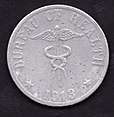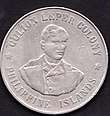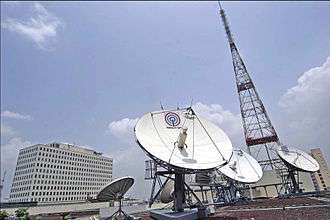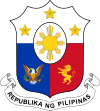Philippine peso
The Philippine peso, also referred to by its Filipino name piso (Philippine English: /ˈpɛsoʊ/, /ˈpiː-/, plural pesos; Filipino: piso [ˈpiso, pɪˈso]; sign: ₱; code: PHP), is the official currency of the Philippines. It is subdivided into 100 centavos or sentimos in Filipino. As a former colony of the United States, the country used English on its currency, with the word "peso" appearing on notes and coinage until 1967. Since the adoption of the usage of the Filipino language on banknotes and coins, the term "piso" is now used.[4]
| Philippine peso | |
|---|---|
| Piso ng Pilipinas (Filipino) | |
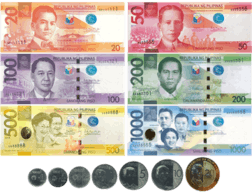 New Generation Currency Series banknotes and coins | |
| ISO 4217 | |
| Code | PHP |
| Number | 608 |
| Denominations | |
| Subunit | |
| 1⁄100 | Sentimo or centavo |
| Symbol | ₱ |
| Banknotes | |
| Freq. used | ₱20, ₱50, ₱100, ₱500, ₱1000 |
| Rarely used | ₱200 |
| Coins | |
| Freq. used | ₱1, ₱5, ₱10, ₱20 |
| Rarely used | 1¢, 5¢, 10¢, 25¢ |
| Demographics | |
| User(s) | |
| Issuance | |
| Central bank | Bangko Sentral ng Pilipinas |
| Website | www |
| Printer | The Security Plant Complex |
| Website | www |
| Mint | The Security Plant Complex |
| Website | www |
| Valuation | |
| Inflation | 2.5%[1] |
| Source | Philippine Statistics Authority, December 2019 |
| Method | CPI |
The Philippine peso sign is denoted by the symbol "₱", introduced under American rule in place of the original peso sign "$" used throughout Hispanic Latin America.[5] Alternative symbols used are "PHP", "PhP", "Php", or just "P".
Banknotes and coins of the Philippines are minted and printed at the Security Plant Complex of the Bangko Sentral ng Pilipinas (Central Bank of the Philippines) in Quezon City.[6][7]
History
The Philippine peso is ultimately derived from the Spanish peso or pieces of eight brought over in large quantities by the Manila galleons of the 16th to 19th centuries. From the same Spanish peso or dollar is derived the various pesos of Latin America, the dollars of the US and Hong Kong, as well as the Chinese yuan and the Japanese yen. References:.[8][9][10]
Pre-colonial coinage
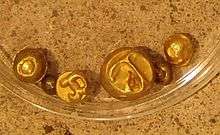
The trade the pre-colonial tribes of what is now the Philippines did among themselves with its many types of pre-Hispanic kingdoms (kedatuans, rajahnates, wangdoms, lakanates and sultanates) and with traders from the neighboring islands was conducted through barter. The inconvenience of barter however later led to the use of some objects as a medium of exchange. Gold, which was plentiful in many parts of the islands, invariably found its way into these objects that included the Piloncitos, small bead-like gold bits considered by the local numismatists as the earliest coin of the ancient peoples of the Philippines, and gold barter rings.[11] The original silver currency unit was the rupya or rupiah, brought over by trade with India and Indonesia.
Two native Tagalog words for money which survive today in Filipino were salapi and possibly pera. Salapi is thought to be from isa (one) + rupya which would become lapia when adapted to Tagalog. Alternately, it could be from Arabic asrafi (a gold coin, see Persian ashrafi) or sarf (money, money exchange). Pera is thought to be from Malay perak (silver), which also has a direct cognate or adaptation in Tagalog/Filipino as pilak.
Spanish colonial period
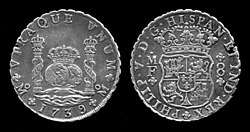
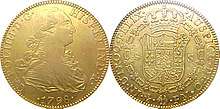
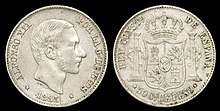
The Spanish silver peso worth eight reales was first introduced by the Magellan expedition of 1521 and brought in large quantities after the 1565 conquest of the Philippines by Miguel López de Legazpi. See Spanish dollar. The local salapi continued under Spanish rule as a toston or half-peso coin. Additionally, Spanish gold onzas or eight-escudo coins were also introduced with identical weight to the Spanish dollar but valued at 16 silver pesos.
The earliest silver coins brought in by the galleons from Mexico and other Spanish colonies were in the form of roughly-cut cobs or macuquinas. These coins usually bore a cross on one side and the Spanish royal coat-of-arms on the other. These crudely-made coins were subsequently replaced by machine-minted coins called Columnarios (pillar dollars) or “dos mundos (two worlds)” in 1732 containing 27.07 grams of 0.917 fine silver (revised to 0.903 fine in 1771).
Fractional currency was supplied by cutting the Spanish dollar coin, most commonly into eight wedges each worth one Spanish real. Locally produced crude copper or bronze coins called cuartos or barrillas (hence the Tagalog/Filipino words cuarta or kwarta, "money" and barya "coin" or "loose change") were also struck in the Philippines by order of the Spanish government, with 20 cuartos being equal to one real (hence, 160 cuartos to a peso). The absence of officially minted cuartos in the 19th century was alleviated in part by counterfeit two-cuarto coins made by Igorot copper miners in the Cordilleras.
A currency system derived from coins imported from Spain, China and neighboring countries was fraught with various difficulties. Money came in different coinages, and fractional currency in addition to the real and the cuarto also existed. Money has nearly always been scarce in Manila, and when it was abundant it was shipped to the provinces. An 1857 decree requiring the keeping of accounts in pesos and centimos (worth 1/100th of a peso) was of little help to the situation given the existence of copper cuartos worth 160 to a peso.
Philippine Gold/Silver Bimetallic standard in the 19th century
The Spanish gold onza (or 8-escudo coin) was of identical weight to the Spanish dollar but was officially valued at 16 silver pesos, thus putting the peso on a bimetallic standard with a gold/silver ratio of 16. Its divergence with the value of gold in international trade featured prominently in the continued monetary crises of the 19th century. In the 1850s the low price of gold in the international markets triggered the outflow of silver coins. In 1875 the adoption of the gold standard in Europe triggered a rise in the international price of gold and the replacement of gold coins with silver pesos. While the Philippines stayed officially bimetallic until 1898 with the peso worth either one silver Mexican peso (weighing 27.07 grams 0.903 fine, or 0.786 troy ounce XAG) or 1/16th the gold onza (weighing 1.6915 gram 0.875 fine, or 0.0476 troy ounce XAU), in reality the gold peso has increased in value to approx. two silver pesos.
Concurrent with these events is the establishment of the Casa de Moneda de Manila in the Philippines in 1857, the mintage starting 1861 of gold 1, 2 and 4 peso coins according to Spanish standards (the 4-peso coin being 6.766 grams of 0.875 gold), and the mintage starting 1864 of fractional 50, 20 and 10 centimo silver coins also according to Spanish standards (with 100 centimos containing 25.98 grams of 0.900 silver; later lowered to 0.835 silver in 1881). The Spanish-Filipino peso remained in circulation and were legal tender in the islands until 1904, when the American authorities demonetized them in favor of the new US-Philippine peso.
The first paper money circulated in the Philippines was the Philippine peso fuerte issued in 1851 by the country's first bank, the El Banco Español Filipino de Isabel II. Convertible to either silver pesos or gold onzas, its volume of 1,800,000 pesos was small relative to about 40,000,000 silver pesos in circulation at the end of the 19th century.
A fanciful etymology for the term pera holds that it was inspired by the Carlist Wars where Queen Isabel II was supposedly called La Perra (The Bitch) by her detractors, and thus coins bearing the image of Isabel II were supposedly called perras, which became pera. A less outlandish Spanish origin, if the term is indeed derived from Spanish, could be the 10-centimo and 5-centimo Spanish coins nicknamed perra gorda and perra chica, where the "bitch" or female dog is a sarcastic reference to the Spanish lion. Arguments against either theory are that the coins bearing the face of Isabel II were nicknamed Isabelinas, and that the perra coins were issued for Spain, not the Philippines.
Revolutionary Period
Asserting its independence after the Philippine Declaration of Independence on June 12, 1898, the República Filipina (Philippine Republic) under General Emilio Aguinaldo issued its own coins and paper currency backed by the country's natural resources. The coins were the first to use the name centavo for the subdivision of the peso. The island of Panay also issued revolutionary coinage. After Aguinaldo's capture by American forces in Palanan, Isabela on March 23, 1901, the revolutionary peso ceased to exist.
American Colonial Period
_50_Centavos_Silver_Coin_1918_(s).jpg)
After the United States took control of the Philippines, the United States Congress passed the Philippine Coinage Act of 1903, established the unit of currency to be a theoretical gold peso (not coined) consisting of 12.9 grains of gold 0.900 fine (0.0241875 XAU). This unit was equivalent to exactly half the value of a U.S. dollar.[12] Its peg to gold was maintained until the gold content of the US dollar was reduced in 1934. Its peg of ₱2 to the US dollar was maintained until independence in 1946.
The act provided for the coinage and issuance of Philippine silver pesos substantially of the weight and fineness as the Mexican peso, which should be of the value of 50 cents gold and redeemable in gold at the insular treasury, and which was intended to be the sole circulating medium among the people. The act also provided for the coinage of subsidiary and minor coins and for the issuance of silver certificates in denominations of not less than 2 nor more than 10 pesos (maximum denomination increased to 500 pesos in 1906).
It also provided for the creation of a gold-standard fund to maintain the parity of the coins so authorized to be issued and authorized the insular government to issue temporary certificates of indebtedness bearing interest at a rate not to exceed 4 percent per annum, payable not more than one year from date of issue, to an amount which should not at any one time exceed 10 million dollars or 20 million pesos.
Culion leper colony currency
The Culion leper colony was established in May 1906 by the Insular Government of the Philippine Islands in Culion Island, Palawan. It was modeled after the Kalaupapa Leprosy Settlement in Molokai, Hawaii. It was issued its own Special Culion Currency due to the erroneous belief that leprosy could be transmitted via handling of money. Only inmates of the colony were allowed to use what was commonly known as "leper money." It was prohibited for inmates to use regular Philippine currency, and it was prohibited for non-lepers to use the Culion currency. The first and second issues (1913 and 1920) were struck in aluminum by the Frank & Co. die establishment. All subsequent issues were minted by the newly reopened Manila Mint. The third issue (1922) was also aluminum, but the fourth, fifth, and sixth issues (1925, 1927, and 1930) were in copper-nickel alloy. The sixth issue was the final issue. In total, around 169,000 coins were struck for the Culion leper colony, between 1913 and 1930.[13][14][15]
By the 1920s, the segregation laws were relaxed. Non-leper settlers (locally known as sano) started coming into the island, mostly family members of the thousands of inmates who were forcibly relocated to the island during via the segregation program. However, exchange of money between the leper inmates and the non-leper settlers was still prohibited. In 1942, during the Japanese invasion of the Philippines in World War II, Culion was cut off from Manila, leading to a shortage of currency. The local Culion authorities issued an emergency currency printed on paper, with centavo denomations in pink paper and peso denominations in blue paper. The Japanese later attacked the island and destroyed its port, radio tower, and electricity generators, cutting off all supplies and contact to the island. This resulted in widespread starvation that resulted in 2,000 deaths. People who fled the island were also killed. It wasn't until 1945 that the US Army Air Corps was able to drop supplies on the island by parachute.[13][16][17]
After independence, the segregation law was revised to allow private home isolation and treatment, removing the need for a leper colony. By the 1980s, multi-drug therapies had reduced the status of leprosy to a treatable disease. In 2006, it was declared a leprosy-free area by the World Health Organization. The currency is discontinued but remains popular among coin collectors.[13][18][19]
Commonwealth Period
.jpg)
When Philippines became a U.S. Commonwealth in 1935, the coat of arms of the Philippine Commonwealth were adopted and replaced the arms of the US Territories on the reverse of coins while the obverse remained unchanged. This seal is composed of a much smaller eagle with its wings pointed up, perched over a shield with peaked corners, above a scroll reading "Commonwealth of the Philippines". It is a much busier pattern, and widely considered less attractive.
World War II
In 1942, the Japanese occupiers introduced fiat notes for use in the Philippines. Emergency circulating notes (also termed "guerrilla pesos") were also issued by banks and local governments, using crude inks and materials, which were redeemable in silver pesos after the end of the war. The puppet state under José P. Laurel outlawed possession of guerrilla currency and declared a monopoly on the issuance of money and anyone found to possess guerrilla notes could be arrested or even executed. Because of the fiat nature of the currency, the Philippine economy felt the effects of hyperinflation.
Combined U.S. and Philippine Commonwealth military forces including recognized guerrilla units continued printing Philippine pesos, so that, from October 1944 to September 1945, all earlier issues except for the emergency guerrilla notes were considered illegal and were no longer legal tender.
Independence and the Central Bank of the Philippines, 1949-1993
.jpg)
Republic Act No. 265 created the Central Bank of the Philippines (now the Bangko Sentral ng Pilipinas) on January 3, 1949, in which was vested the power of administering the banking and credit system of the country. Under the act, all powers in the printing and mintage of Philippine currency was vested in the CBP, taking away the rights of the banks such as Bank of the Philippine Islands and the Philippine National Bank to issue currency.[20]
The Philippines faced various post-war problems due to the slow recovery of agricultural production, trade deficits due to the need to import needed goods, and high inflation due to the lack of goods. The CBP embarked on a fixed exchange system during the 1950s where the peso's convertibility was maintained at ₱2 per US$1 by various measures to control and conserve the country's international reserves.[21]
This system, combined with other “Filipino First” efforts to curtail importations, helped reshape the country's import patterns and improve the balance of payments. Such restrictions, however, gave rise to a black market where dollars routinely traded for above ₱3/$. The CBP's allocation system which rations a limited supply of dollars at ₱2/$ to purchase priority imports was exploited by parties with political connections. Higher black market exchange rates drove remittances and foreign investments away from official channels.
By 1962 the task of maintaining the old ₱2/$ parity while defending available reserves has become untenable under the new Diosdado Macapagal administration, opening up a new decontrol era from 1962-1970 where foreign exchange restrictions were dismantled and a new free-market exchange rate of ₱3.90/$ was adopted since 1965. This move helped balance foreign exchange supply versus demand and greatly boosted foreign investment inflows and international reserves. However, a weak manufacturing base that can't capture market share in (mostly imported) consumer goods meant that devaluation only fueled inflation, and by the time the decontrol era ended in 1970 another devaluation to ₱6.43/$ was needed.
In 1967, coinage adopted Filipino language terminology instead of English, banknotes following suit in 1969. Consecutively, the currency terminologies as appearing on coinage and banknotes changed from the English centavo and peso to the Filipino sentimo and piso. However, centavo is more commonly used by Filipinos in everyday speech.
The CBP's final era from 1970 until the BSP's reestablishment in 1993 involved a managed float system with no more fixed parity commitments versus the dollar. The CBP only committed to maintain orderly foreign exchange market conditions and to reduce short-term volatility. Difficulties continued throughout the 1970s and 1980s in managing inflation and keeping exchange rates stable, and was complicated further by the CBP lacking independence in government especially when the latter incurs fiscal shortfalls. The worst episode occurred when a confidence crisis in the Ferdinand Marcos administration triggered a capital flight among investors between August 1983 to February 1986, nearly doubling the exchange rate from ₱11/$ to ₱20/$ and also doubling the prices of goods.
Reorganization to the new Bangko Sentral ng Pilipinas

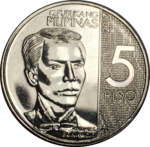
Positive political and economic developments in the 1990s paved the way for further economic liberalization and an opportunity to unburden the central bank of objectives that are inconsistent with keeping inflation stable. The New Central Bank Act (Republic Act No 7653) of 14 June 1993 replaces the old CBP with a new Bangko Sentral ng Pilipinas mandated explicitly to maintain price stability, and enjoying fiscal and administrative autonomy to insulate it from government interference. This, along with the further liberalization of various foreign exchange regulations, puts the Philippine peso on a fully floating exchange rate system. The market decides on the level in which the peso trades versus foreign currencies based on the BSP's ability to maintain a stable inflation rate on goods and services as well as sufficient international reserves to fund exports. Black market exchange rates as seen in the past are now nonexistent since official markets now reflect underlying supply and demand.[22]
The Philippine peso has since traded versus the US dollar in a range of ₱24-46 from 1993–99, ₱40-56 from 2000-2009, and ₱40-54 from 2010-2019. The previous 1903-1934 definition of a peso as 12.9 grains of 0.9 gold (or 0.0241875 XAU) is now worth ₱1,252 based on gold prices as of September 2015.[23]
Names for different denominations
The smallest currency unit is called centavo in English (from Spanish centavo). Following the adoption of the "Pilipino series" in 1967, it became officially known as sentimo in Filipino (from Spanish céntimo).[24] However, "centavo" and its local spellings, síntabo and sentabo, are still used as synonyms in Tagalog. It is the most widespread preferred term over sentimo in other Philippine languages, including Abaknon,[25] Bikol,[26] Cebuano,[27][28] Cuyonon,[29] Ilocano,[30] and Waray,[25] In Chavacano, centavos are referred to as céns (also spelled séns).[31]
Coins
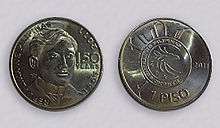
The American government deemed it more economical and convenient to mint silver coins in the Philippines, hence, the re-opening of the Manila Mint in 1920, which produced coins until the Commonwealth Era.
In 1937, coin designs were changed to reflect the establishment of the Commonwealth. During the Second World War, no coins were minted from 1942 to 1943 due to the Japanese Occupation. Minting resumed in 1944-45 for the last time under the Commonwealth. Coins only resumed in 1958 after an issuance of centavo-denominated fractional banknotes from 1949 to 1957.
In 1958, new coinage entirely of base metal was introduced, consisting of bronze 1 centavo, brass 5 centavos and nickel-brass 10, 25 and 50 centavos. In 1967, the coinage was altered to reflect the use of Filipino names for the currency units. One-peso coins were introduced in 1972. In 1975, the Ang Bagong Lipunan Series was introduced with a new 5-peso coin included. Aluminium replaced bronze, and cupro-nickel replaced nickel-brass that year. The Flora and Fauna series was introduced in 1983 which included 2-peso coins. The sizes of the coins were reduced in 1991, with production of 50-centavo and 2-peso coins ceasing in 1994. The next series of coins was introduced in 1995, with 10-peso coins added in 2000. The current series, all struck on nickel-plated steel, and omitting the 10-centavo denomination, was introduced in 2017 with the 5-peso coin and in 2018 with the other five denominations.
In July 2019, the BSP announced plans to replace the 20 peso bill with a coin by the 1st quarter of 2020.[32]
Denominations worth P0.25 (~$0.005) and below are still issued but have been increasingly regarded as a nuisance. Proposals to retire and demonetize all coins less than one peso in value have been rejected by the government and the BSP.[33]
Banknotes
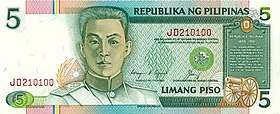
In 1949, the Central Bank of the Philippines took over paper money issue. Its first notes were overprints on the Victory Treasury Certificates. These were followed in 1951 by regular issues in denominations of 5, 10, 20 and 50 centavos, 1, 2, 5, 10, 20, 50, 100, 200 and 500 pesos. The centavo notes (except for the 50-centavo note, which would be later known as the half-peso note) were discontinued in 1958 when the English Series coins were first minted.
In 1967, the CBP adopted the Filipino language on its currency, using the name Bangko Sentral ng Pilipinas, and in 1969 introduced the Pilipino Series of notes in denominations of 1, 5, 10, 20, 50 and 100 pesos. The Ang Bagong Lipunan Series was introduced in 1973 and included 2-peso notes. A radical change occurred in 1985, when the CBP issued the New Design Series with 500-peso notes introduced in 1987, 1000-peso notes (for the first time) in 1991 and 200-peso notes in 2002.
The New Design Series was the name used to refer to Philippine banknotes issued from 1985 to 1993. It was then renamed as the BSP Series due to the re-establishment of the Bangko Sentral ng Pilipinas in 1993. It was succeeded by the New Generation Currency Series issued on December 16, 2010.
The New Design/BSP Series banknotes were still in print until 2013. Existing banknotes remained legal tender until the start of the demonetization process on January 1, 2015. The bills were originally to be demonetized by January 1, 2017,[34][35][36][37][38][39] but the deadline for exchanging the old banknotes was extended twice, on June 30, 2017 and December 29, 2017. After that date, all NDS/BSP banknotes were demonetized and are no longer a liability of the Bangko Sentral ng Pilipinas.[40][41]
New Generation Currency (current)
In 2009, Bangko Sentral ng Pilipinas (BSP) announced that it has launched a massive redesign for current banknotes and coins to further enhance security features and improve durability.[42] The members of the numismatic committee include BSP Deputy Governor Diwa Guinigundo and Ambeth Ocampo, Chairman of the National Historical Institute. The new banknote designs feature famous Filipinos and iconic natural wonders. Philippine national symbols will be depicted on coins. The BSP started releasing the initial batch of new banknotes in December 2010.
Several, albeit disputable, errors have been discovered on banknotes of the New Generation series and have become the subject of ridicule over social media sites. Among these are the exclusion of Batanes from the Philippine map on the reverse of all denominations, the mislocation of the Puerto Princesa Subterranean Underground River on the reverse of the 500-peso bill and the Tubbataha Reef on the 1000-peso bill, and the incorrect coloring on the beak and feathers of the blue-naped parrot on the 500-peso bill,[43][44] but these were eventually realized to be due to the color limitations of intaglio printing.[45] The scientific names of the animals featured on the reverse sides of all banknotes were incorrectly rendered as well.[46]
By February 2016, the BSP started to circulate new 100-peso bills which were modified to have a stronger mauve or violet color. This was "in response to suggestions from the public to make it easier to distinguish from the 1000-peso bank note". The public could still use the New Generation Currency 100-peso bills with fainter colors as they are still acceptable.[47]
On December 11, 2019, Banko Sentral ng Pilipinas (BSP) announced that the twenty-peso banknote will be changed to a coin. The BSP announced a banknote to coinage change by 2020 and 2021 and will end at the end of 2021 or the beginning of 2022. Former President of the Philippines Manuel L. Quezon's face was kept in the coin design. The BSP also announced a redesign for the New Generation Currency 5 peso coin. The new design involves adding bumps on each side of the circle (nonagonal). [48][49]
Exchange rates
Historical exchange rate
The official exchange rate was ₱2 against the U.S. dollar from 1946–62, devalued to ₱3.90/$ in 1962, and devalued again to ₱6.43/$ in 1970. Black market exchange rates during these periods, however, were nearly always higher than official rates.
Several depreciations followed, with the peso trading at ₱18/$ in 1984 from the dirty float at ₱11.25/$ in 1983 [50] and ₱21/$ in 1986. In the early 1990s, the peso depreciated again to ₱28/$. Due to the 1997 Asian financial crisis, the peso depreciated from ₱26/$ in July 1997 to ₱46.50/$ in 1998 and to about ₱50/$ in 2001. Black market exchange rates as seen in the past are now nonexistent since official exchange rates now reflect underlying supply and demand rather than political considerations.
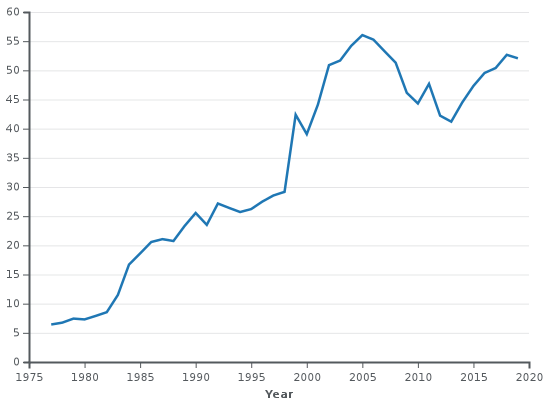
Current exchange rate
| Current PHP exchange rates | |
|---|---|
| From Google Finance: | AUD CAD CHF EUR GBP HKD JPY USD INR |
| From Yahoo! Finance: | AUD CAD CHF EUR GBP HKD JPY USD INR |
| From XE.com: | AUD CAD CHF EUR GBP HKD JPY USD INR |
| From OANDA: | AUD CAD CHF EUR GBP HKD JPY USD INR |
| From fxtop.com: | AUD CAD CHF EUR GBP HKD JPY USD INR |
Recent issues
Errors in currency
In 2005, About 78 million 100-peso notes with President Gloria Macapagal Arroyo’s surname misspelt as "Arrovo" were printed and planned to be circulated. The error was only found out after 2 million of the notes were circulated and the BSP had ordered an investigation.[51][52][53]
The incorrect manner in which scientific names were printed in the 2010 New Generation Currency Series were addressed in 2017 revisions.
In December 2017, a 100 peso banknote which had no face of Manuel A. Roxas and no electrotype 100 was issued. The Facebook post was shared over 24,000 times. The BSP said that the banknotes are due to a rare misprint.[54][55]
1-peso coin fraud
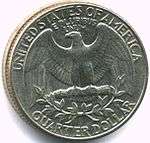
By August 2006, it became publicly known that the 1-peso coin has the same size as the 1 United Arab Emirates dirham coin.[56] As of 2010, 1-peso is only worth 7 fils (0.07 dirham), leading to vending machine fraud in the UAE. Similar frauds have also occurred in the US, as the 1-peso coin is roughly the same size as the quarter but as of 2017 is worth slightly less than 2 U.S. cents. Newer digital parking meters are not affected by the fraud, though most vending machines will accept them as quarters.
Non-existent currency
In 2017, a one-peso coin that was allegedly minted in 1971 was said to bear the design of the novel Noli Me Tángere by Jose Rizal at the back of the coin. The coin was allegedly sold for up to PHP 1,000,000. The holder of the said coin was interviewed by Kapuso Mo, Jessica Soho about this, but potential buyers made no serious offers to purchase the coin, and the BSP said that it did not release any coin of the said design. The BSP also mentioned that the coin is thinner than the circulating coin which gives the possibility that someone might have tampered it and replaced it with a different design.[57]
In June 2018, a Facebook page posted a 10,000-peso note with a portrait of President Ramon Magsaysay on the front and a water buffalo and Mount Pinatubo on the back. The Bangko Sentral ng Pilipinas did not issue this banknote and stressed that only 6 denominations are in current circulation (20-, 50-, 100-, 200-, 500- and 1000 pesos). The Facebook page of the BSP said that it was fake. The signature was also of former governor of the Bangko Sentral ng Pilipinas Amando Tetangco Jr..[58] It was found out that the photo was from a different user who found a fake 10,000 peso banknote in a book at a library.
Peso drops past ₱52 amid market jitters
In September 2018, the value of the Philippine peso dropped from ₱54 to a dollar. This is the lowest it has been in almost 13 years due to an ongoing rout against emerging market currencies and a stubbornly high local inflation rate. On the foreign exchange market, the peso ended the trading session at ₱54.13. It has since recovered to ₱52 as of November 2018.[59]
See also
- Economy of the Philippines
References
- "Inflation rates". www.psa.gov.ph. Retrieved 2020-01-15.
- "ISO 4217 AMENDMENT NUMBER 168" (PDF). www.currency-iso.org. 2 August 2018. Retrieved 2019-09-26.
- From September 2017 to 2 August 2018, the ISO 4217 standard referred to the currency by the Filipino term "piso".[2] It has since been changed back to "peso".[3]
- Shafer, Neil (1964). A Guide Book of Philippine Paper Money. Whitman Publishing. p. 19. ASIN B0007EJ9OC. Retrieved January 26, 2019.
- "Overview of the BSP". Bangko Sentral ng Pilipinas (BSP) Official Website. Retrieved on 2013-10-01.
- "Compare currencies in South East Asia". aroundtheworldinaday.com. Retrieved 15 July 2014.
- "Bangko Sentral ng Pilipinas - BSP Notes and Coins - History of Philippine Money". www.bsp.gov.ph.
- "Report of the Philippine commission to the President, January 31, 1900, page 142-149, Part IX: The Currency". 1900.
- Babones, Salvatore (April 30, 2017). "'The Silver Way' Explains How the Old Mexican Dollar Changed the World". The National Interest.
- Coinage of the Pre-Hispanic Era Evolution of Philippine Currency. Bangko Sentral ng Pilipinas. Retrieved on 13 October 2013.
- Edwin Walter Kemmerer (2008). "V. The Fundamental Laws of the Philippine Currency reform". Modern Currency Reforms; A History and Discussion of Recent Currency Reforms in India, Porto Rico, Philippine Islands, Straits Settlements and Mexico. Macmillan. ISBN 978-1-4086-8800-7.
- Lannon, Donald (2017). "Disinfect Before Handling: The Story of Culion Leper Colony and Its Coinage" (PDF). The California Numismatist. 14 (2): 28–40.
- Jarcho, S. (1973). "Medical Numinsmatic Notes, IX: Coins of the Leper Colony at Culion and of the Philippine Health Service". Bulletin of the New York Academy of Medicine. 49 (2): 156–159. PMC 1806917. PMID 4567272.
- Perez, Gilbert Somers (1929). "The Leper Colony Currency of Colon". Numismatic Notes and Monographs.
- Arcilla, José S. (2009). "The Culion Leper Colony, 1900s-1970s". Philippine Studies. 57 (2): 307–326. JSTOR 42634012.
- Pe, Roger (16 June 2018). "Culion: Symbol for a health nightmare a century ago, leper colony's archives are now an important part of global memor". BusinessMirror. Retrieved 18 June 2019.
- Pe, Roger (25 January 2016). "Culion: A beautiful story to tell". Philippine Daily Inquirer. Retrieved 18 June 2019.
- "Culion Leprosy Colony (Philippines)". History of Leprosy. International Leprosy Association. Retrieved 18 June 2019.
- "Republic Act No. 265". June 15, 1948. Retrieved February 6, 2015.
- "p 33 Appendix of "BSP Working Paper Series No. 2008-02 – Adjustments in the Face of Peso Volatility: Perspective from the Past and Policy Directions" (PDF).
- "Bangko Sentral ng Pilipinas - About the Bank - History". www.bsp.gov.ph.
- "XE Currency Converter; XAU to PHP". Retrieved February 6, 2015.
- "History of Philippine Currency - Demonetized Coin Series". Bangko Sentral ng Pilipinas. Retrieved 2 February 2016.
- Voltaire Q. Oyzon & the National Network of Normal Schools. "Commerce". 3NS Corpora Project. Retrieved 2 February 2016.
- "Bulan ni Balagtas". Planet Naga. 5 April 2009. Retrieved 2 February 2016.
- "sentabo". Binisaya.com, English to Binisaya - Cebuano Dictionary and Thesaurus. Retrieved 27 August 2011.
- Tom Marking (7 November 2005). "Cebuano Study Notes" (PDF). LearningCebuano.com. Retrieved 2 February 2016.
- Ester Ponce De Leon Timbancaya Elphick & Virginia Howard Sohn. "Pagsorolaten i' Cuyonon". Bisarang Cuyonon: The Official Language of Palawan. Retrieved 2 February 2016.
- Precy Espiritu (1984). Let's Speak Ilokano. University of Hawaii Press. p. 224. ISBN 9780824808228.
- John M. Lipski & Salvatore Santoro (2000). "Zamboangueño Creole Spanish" (PDF). Comparative Creole Syntax: 1–40.
- "Bangko Sentral to create P20 coin". Rappler.
- "Scrapping lower-valued coins unfair to consumers". GMA News Online.
- BSP Announces the Replacement Process of Old Banknotes (New Design Series, NDS) with New Generation Currency Banknotes Bangko Sentral ng Pilipinas (bsp.gov.ph). December 29, 2014. Retrieved on 2014-12-30.
- Poster for the demonetization of the New Design/BSP series (English) Bangko Sentral ng Pilipinas (bsp.gov.ph). Retrieved on 2016-01-21.
- Poster for the demonetization of the New Design/BSP series (Filipino) Bangko Sentral ng Pilipinas (bsp.gov.ph). Retrieved on 2016-01-21.
- Poster for the demonetization of the New Design/BSP series (Ilocano) Bangko Sentral ng Pilipinas (bsp.gov.ph). Retrieved on 2016-01-21.
- Poster for the demonetization of the New Design/BSP series (Cebuano) Bangko Sentral ng Pilipinas (bsp.gov.ph). Retrieved on 2016-01-21.
- Poster for the demonetization of the New Design/BSP series (Bicolano) Bangko Sentral ng Pilipinas (bsp.gov.ph). Retrieved on 2016-01-21.
- BSP Extends the Period for the Exchange or Replacement of New Design Series Banknotes at Par with the New Generation Currency Banknotes, Bangko Sentral ng Pilipinas press release, December 28, 2016
- BSP extends deadline for the exchange/replacement of old note series (NDS) at par with the new note series (NGC) until 30 June 2017 Bangko Sentral ng Pilipinas (www.bsp.gov.ph). Retrieved on 2017-03-26.
- "The New Generation Currency Program of the Philippines". Bangko Sentral ng Pilipinas. March 26, 2010. Retrieved February 6, 2015.
- "Errors found on new peso bills". ABS-CBN News and Current Affairs. December 19, 2010. Retrieved February 6, 2015.
- "Error-filled peso bills spark uproar". Philippine Daily Inquirer. December 20, 2010. Retrieved February 6, 2015.
- Lucas, Daxim (January 1, 2011). "The peso's makeover from an insider's view". Philippine Daily Inquirer. Archived from the original on February 6, 2015. Retrieved February 6, 2015.
- "Philippine Money - Peso Coins and Banknotes: Error in Scientific Names on New Generation Banknotes". Retrieved February 6, 2015.
- Vera, Ben O. de. "BSP releases new P100 bills". business.inquirer.net. Retrieved 2016-02-04.
- "Banko Sentral launches new P20 coin, enhanced P5". ABS-CBN News and Current Affairs. November 29, 2019. Retrieved December 11, 2019.,
- "BSP releases new design for 5-peso coin and introduces 20-peso coin". GMA News. December 17, 2019. Retrieved December 17, 2019.
- "Philippine Peso Devalued 11 To A US Dollar". New Straits Times. June 23, 1983. Retrieved February 6, 2014.
- "'Arrovo' bills to be replaced; firm to pay cost". Philippine Daily Inquirer. October 10, 2006. Retrieved February 6, 2015.
- "Typo drives up peso's 'worth' - ABC News (Australian Broadcasting Corporation)". mobile.abc.net.au. Retrieved 2018-07-29.
- "Philippine Money - Peso Coins and Banknotes: Banknote Error - "Arrovo" on 100 Peso Banknote". Philippine Money - Peso Coins and Banknotes. Retrieved 2018-07-29.
- News, ABS-CBN. "'Faceless' bills due to 'rare misprint,' Bangko Sentral says". ABS-CBN News. Retrieved 2018-07-29.
- Philippines bank left red-faced over 'faceless' notes https://www.channelnewsasia.com/news/asia/philippines-bank-left-red-faced-over-faceless-notes-9816786
- Menon, Sunita (August 1, 2006). "Hey presto! A Peso's as good as a Dirham". gulfnews.com. Retrieved February 6, 2015.
- GMA Public Affairs (2017-08-21), Kapuso Mo, Jessica Soho: Isang milyong piso kapalit ng 1971 piso?, retrieved 2018-07-29
- Bangko Sentral warns against fake ₱10,000 bill http://cnnphilippines.com/news/2018/06/23/bsp-fake-ten-thousand.html
- Lucas, Daxim L. "Peso drops past P54 amid market jitters". Retrieved 2018-09-12.
Bibliography
- Banknotes and Coins June 2010, Bangko Sentral ng Pilipinas (BSP).
- Philippine Coins at the Bohol.ph website
- Krause, Chester L.; Clifford Mishler (1991). Standard Catalog of World Coins: 1801–1991 (18th ed.). Krause Publications. ISBN 0873411501.
- Pick, Albert (1994). Standard Catalog of World Paper Money: General Issues. Colin R. Bruce II and Neil Shafer (editors) (7th ed.). Krause Publications. ISBN 0-87341-207-9.
External links
- Virtual Museum of Spanish Philippine Coinage
- Philippine Guerrilla and Emergency Notes
- Philippine Coin News & Update
- Philippine Banknotes and Coins
- American Revolutionary Coins Countermarked in Philippines
